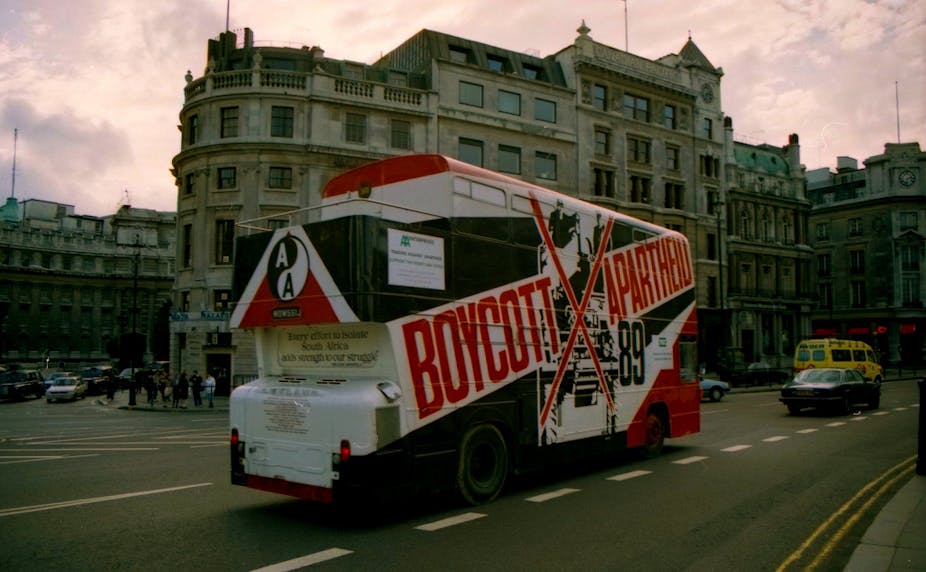It’s not very often that a book really reshapes our perception of an issue, but Hennie van Vuuren’s “Apartheid, Guns and Money: a tale of profit” is one. It is a massive work: over 600 pages and the result of a decade of meticulous, painstaking work.
From a modest office in a rundown suburb of Cape Town, Van Vuuren has been beavering away to probe into the stories that could never be told during the apartheid years. Formerly director at the Institute for Security Studies, he now runs Open Secrets, which peers into economic and human rights violations. This volume, first published in South African in 2017, is the result.
The extraordinary tale that Van Vuuren tells is how – as the South African state gradually became an international pariah and as the truth about apartheid became internationally known – it moved from a normal member of the world community to a covert operator. It began working in shady ways, through even more shady operators.
To ensure that it had access to arms and oil, Pretoria moved from legitimate to illegitimate trade; from overt to covert deals and from legal to illegal transactions. This was supported (or at least connived at) by many western powers. That the US, Britain and France did this has been known, or at least suspected, for many years. Van Vuuren fills in the blanks and gives us plenty of new information on this. Although shocking this is less than astonishing.
What is really novel is that he uncovers a completely new set of actors: the Chinese and the Soviet Union. In the past it has been assumed that, for the most part, they were completely wedded to the liberation movements. The support from Moscow and Beijing for the African National Congress and – to a lesser extent – the Pan Africanist Congress, was so widely reported that few suspected there might be less than total solidarity between the communist powers and the liberation movements.
Yes, there were the odd stories about the South African diamond giant – De Beers – being spotted at the ballet in Moscow doing deals with Russian diamond companies, but this was seen as a small aberration. After all, both countries wanted to keep up the prices of diamonds on international markets, so some kind of arrangement was perhaps inevitable.
But – if Van Vuuren is right – these relationships went far, far beyond the odd contact.
Mind-boggling complexity
Take one example: the voyage of the Pia Vesta, now a rusting hulk, lying off the coast of Venezuela. This vessel was, says Van Vuuren
once at the centre of one of the greatest arms heists of the 1980s involving socialist East Germany, South Africa, Peru, Panama, probably the CIA and a crafty French arms dealer by the name of Georges Starckmann.
The tale begins with a top secret minute of a meeting between the head of the South African Defence Force, Jannie Geldenhuys, and his senior officials in connection with operation “Daisy”. This was an attempt to recover $20 million that Starckmann had allegedly swindled out of the South Africans.
The story is of mind-boggling complexity, but involves Starckmann doing a deal with an East German firm called IMES, run by the East German deputy foreign minister with Stasi employees – members of the East German secret service. The result was an arrangement which involved 60 shipments of weapons to South Africa via a Danish shipping company. The shipments were to be trailed half way around the world to disguise their final destination.
These shipments were for vital military equipment, including 1,400 anti-tank missiles. The weapons, which had Peruvian end-user certificates, ended up off the coast of Panama where the ruler, General Noriega, had apparently given the green light for the operation. In the end the dictator reneged on the deal. When the Pia Vesta arrived in Panama on 14 June 1986 its crew was arrested and the vessel impounded. In 1989 General Noriega was ousted by the Americans.
How the ship ended up sunk off Venezuela is a bit of a mystery, but then, as Van Vuuren points out, so is much of this story. He concludes that South Africa’s state arms dealer, Armscor, was involved:
But for all the smoke and mirrors, one thing is as clear as day. There is more than sufficient evidence that Armscor bought arms from IMES, a Stasi-run East German company operating behind the Iron Curtain. During the Cold War, much was not as it seemed.
Nor was this an isolated incident. Van Vuuren says he has evidence that Armscor had a team of military experts working inside the Soviet Union with an office in Leningrad. So close was the relationship that when the Chernobyl nuclear reactor disaster took place in 1986, the Russians turned to South Africa for medical support.
The relationship with China
The relationship that the book portrays between South Africa and the Chinese is just as complex. It involves purchases of Chinese military equipment – everything from machine guns to missiles and rocket launchers – using Congolese companies as a front. Sometimes the shipments were destined for South Africa’s Angolan allies, UNITA, sometimes not.
Overall the book is a compelling and convincing narrative: our understanding of apartheid’s global supporters has been transformed.
“Apartheid, Guns and Money: a tale of profit” will be published by Hurst, 1 November 2018, Hardback: £25. pp. 620

